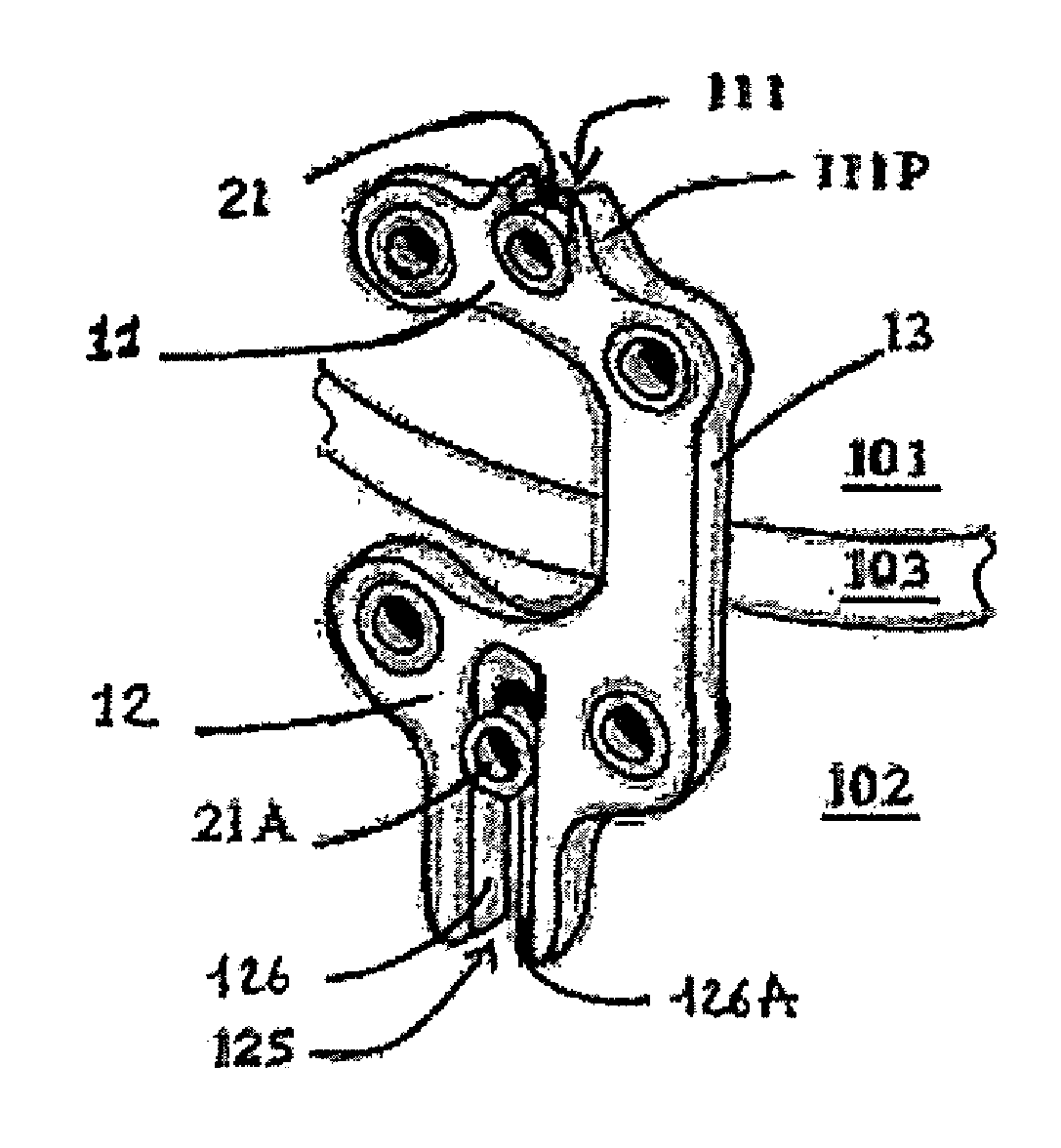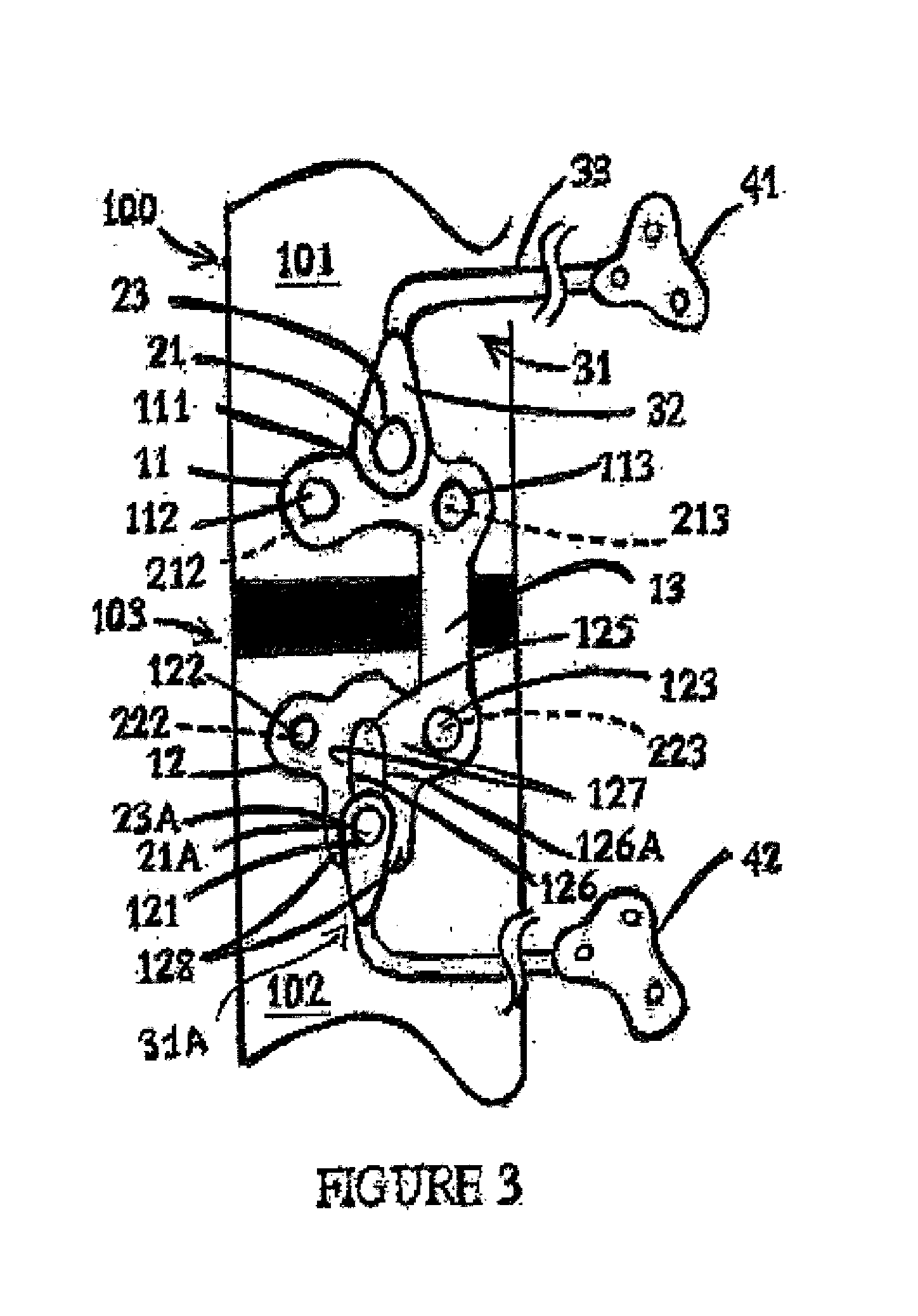Osteosynthesis device
a technology of osteosynthesis and device, applied in the field of osteosynthesis devices, can solve the problems of difficult measurement of hka value, damage to bone integrity, damage to bone, etc., and achieve the effect of any risk of wrenching or playing
- Summary
- Abstract
- Description
- Claims
- Application Information
AI Technical Summary
Benefits of technology
Problems solved by technology
Method used
Image
Examples
first embodiment
1. First Embodiment
[0109]FIGS. 1A to 1D schematically illustrate the progress of an osteotomy operation for opening a bone 100 which in this case is a tibia, i.e. an elongated bone. Clearly, the bone 100 could be any other bone whose shape has to be modified by incision.
[0110]In FIG. 1A, a femur 90 has a direction of extension 50 which represents precisely a straight line linking a geometrical center of rotation of the upper end of the femur 90, situated in the hip, to a geometrical center of rotation at the knee. The tibia 100 has a direction of extension 150 which corresponds to a straight line linking its geometrical center of rotation of the knee with its geometrical center of rotation at the ankle It can be seen that the directions 50, 150 have a relative obliqueness which is excessive. It is therefore necessary to make the tibia 100 pivot in a clockwise direction in order to reduce this angle.
[0111]FIG. 1B shows that an osteotomy is made on the tibia 100, i.e. that the tibia i...
second embodiment
2. Second Embodiment
[0155]FIG. 15 is a view in perspective of the second embodiment of an osteosynthesis plate. The elements identical to those of the first embodiment have kept their reference numbers and the functionally homologous elements carry an additional suffix B.
[0156]The plate 1B of the second embodiment has an overall shape similar to that of the plate 1, with a first base 11B, a second base 12B and a linking tab 13B. However, it differs from the plate 1 in the fact that the first attachment hole 111B in the first base 11B is a hole with a closed rim, that is circular or axially oblong. The aperture 125, herein referenced 125B, is in duplicate, and forms an axially oblong hole with a closed rim. It will be noted however that the fact the rim of the first attachment hole 111B and the apertures 125 are closed does not constitute a necessary characteristic, but means only that the coupling with the attachment and support screws 21B, 21AB does not require a cut in this rim.
[0...
third embodiment
3. Third Embodiment
[0165]FIG. 21 is a plane view illustrating a third embodiment. The elements homologous to an element of the first embodiment bear the same numerical reference followed by the suffix C.
[0166]One original feature of the third embodiment lies in the fact that the monoblock unit formed by the three functional elements 11-13 is replaced by an assembly of three separate elements, namely a first base 11C and a second base 12C which serve as bases for an adjustable element for their mutual linkage, in the form of a strap 13C, which herein is a strap in duplicate to improve the stability and enable the setting of the slope and of the aperture.
[0167]The first base 11C is functionally identical to the first base 11 and similarly has three holes 111C, 112C, 113C, each for a classic screw or a first attachment and support screw 21. As in the case of the first base 11, the holes 111C and 113C are not aligned and, specifically, are arranged according to the vertices of a substan...
PUM
 Login to View More
Login to View More Abstract
Description
Claims
Application Information
 Login to View More
Login to View More - R&D
- Intellectual Property
- Life Sciences
- Materials
- Tech Scout
- Unparalleled Data Quality
- Higher Quality Content
- 60% Fewer Hallucinations
Browse by: Latest US Patents, China's latest patents, Technical Efficacy Thesaurus, Application Domain, Technology Topic, Popular Technical Reports.
© 2025 PatSnap. All rights reserved.Legal|Privacy policy|Modern Slavery Act Transparency Statement|Sitemap|About US| Contact US: help@patsnap.com



